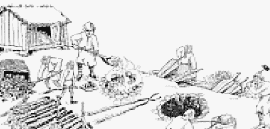Meet the Middle Ages
BackHow iron was produced?

When medieval people produced iron, they needed a lot of firewood and iron ore. Wood was taken from the forests, and iron ore was found in bogs and marshes. An oily film can sometimes be seen on the surface of the water in a bog. Today, people often think that this means that the water is polluted, but that is not the case. The oily film is a sign that iron ore is being formed in the bog. Late in the spring or early in the summer, people walked out to places where this oily film had been seen. They prodded the surface with wooden sticks. If they were fortunate, there was a crunching sound when the stick broke through a layer of iron ore.
Then they started digging the ore with a spade. Not all ore was suitable for the production of iron. Iron ore comes in different colours, and the best kind is a dark, brownish red. An iron-maker would put a little iron in his mouth and chew it. If it was sticky, the quality was good. After it was dug up, the iron ore was dried, usually near the place where the iron was refined.
Autumn was the best time to refine the iron. This was done to get rid of remains of plants in the bog-ore. A fire was built and the iron ore was put on the top of the pile. As the wood burned, the iron ore trickled down among the burning logs and was cleaned from the plants. Late in the autumn or in the winter, it was time to bring the refined ore to the furnace to make the iron. The furnace was either built on the ground, a so-called shaft furnace, or was dug into the ground, a pit furnace. The furnace was barely 1 meter tall or deep and 40 centimetres wide and it was built of stones.
Clay was used as mortar between the stones. When the furnace was ready, it was filled with charcoal and iron ore. To make the furnace really hot, air was blown into the furnace, using bellows. The air was led into the furnace through a hole in the furnace wall. The iron-maker started working the bellows when he had set the coal on fire. After a while, coal and iron ore fell down into the furnace, and then it was time to fill it up again. It took two persons to do this work, one who worked the bellows and one who filled the furnace with new coal and ore.
The temperature in the furnace was not high enough for the iron to melt. Instead, everything in the furnace that was not iron melted. It ran down to the bottom of the furnace, forming lumps, usually called slag. The iron was a sticky and soft lump next to the hole where the air from the bellows had entered the furnace. After about eight hours, the iron could be taken out with long pliers. The resulting lump of iron weighed about 1 or 2 kilos.
The iron that was taken out from the furnace was still not pure and could not be forged. By repeatedly heating the iron and striking it with a hammer on an anvil, it was purified. After this, the lump of iron weighed 0,25-0,5 kilos.
Iron mined in Bergslagen was melted in large and hot furnaces, so called blast-furnaces. The blast furnace was hot enough to make the iron ore melt completely.